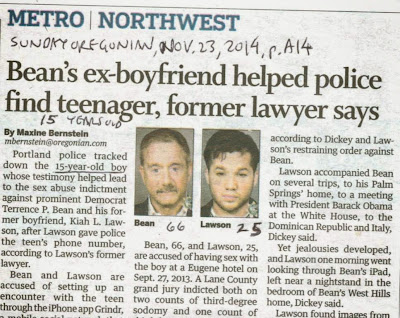PHOTO: A very hard to find and very small 8.84 pound Frozen Li'l Butterball Turkey brand (typical weight 6 to 11 lbs.) is shown on my kitchen cutting board ready to be thawed in the refrigerator, breast side up, for 4 days before Thanksgiving Day. I was able to find one 6 pounder in a previous year and this year every turkey below 10 lbs. in weight was sold out several months before Thanksgiving Day Thursday, Nov. 27, 2014. I love buying the smaller of these turkeys instead of the traditional turkeys, which are often more than 20 pounds and suitable only for a huge family gathering instead of for what the Butterball info page calls "more intimate gatherings." Sure, even with the smaller turkeys I have to freeze leftover turkey in vacuum sealed bags, but it is not so many leftovers that it fills up the freezer and gets freezer burned because it takes so long to consume it.
PHOTO: Cooking instructions provided inside of the Reynolds Kitchens Large Oven Bags reynoldskitchens.com (See Reynolds Large Oven Bags Cooking Chart (PDF)) that the manufacturer says is for, "Making tastier, juicier turkey and in less time -- Cooking moist and tender meats and vegetables -- Making a one-pan meal with easy clean-up." The instructions suggest a 350 degree F. oven and to distribute 1 Tablespoon of flour inside the cooking bag to prevent sticking, and after brushing the turkey with seasoning, then close the bag and cut a few slits in the top of the bag for venting while baking for about 2 hours for an 8 pound turkey. Using an oven meat thermometer placed in the thigh as directed until it read 180 degree F Fahrenheit (and the center of the stuffing read 160 degrees), it took about two hours of cooking time for this 8.84 pound turkey, which had been thawed for four days before cooking.
PHOTO: A traditional custom baked and decorated birthday cake with two candles to be put on top.
In an act of pure gluttony and pleasure, on Thanksgiving Day Nov. 27, 2014 I plan to cook and eat part of the above 8.84 lbs. Li'l Butterball Turkey along with a birthday cake for my "last supper" because I am not sure if I will live to see another Thanksgiving Day -- if this sounds too melodramatic and macabre, please note that as a child I set the goals for myself to grow up to be six feet tall, a millionaire and live to be the age of 100 years old. Ironically, I achieved the first goal to be six feet tall and I want to go on record stating that I still aspire to meet all of my childhood goals, however, I must note that being a millionaire today is even harder because it requires accumulating assets of more than $8 million given inflation.
I've written about cooking technology before (See previous post Sous-vide cooking method for steaks and eggs (4/24/13)) and perhaps my current interest in it is a form of psychic channeling from my late father who had a Ph.D. in Chemical Engineering and contributed to the invention of engineered food at General Mills in the middle Twentieth Century. Similarly, the plastic mesh bag surrounding this turkey was made from nylon, which is also channeling my Ph.D. grandfather Elmer O. Kraemer who led the invention of it at DuPont. (See previous post Elmer Kraemer, chemist, nylon, synthetic rubber pioneer (10/8/09) and Elmer Kraemer (Wikipedia wikipedia.org))
For example, the science of heat transfer and thermodynamics theory can be applied to the Web page calculator "How To Thaw," by Butterball, accessed Nov. 10, 2014 on the www.butterball.com site, which calculates that a 9 lb. turkey will take 2 days 6 hours in the refrigerator, but given my past experience, and the fact that my refrigerator is set colder than normal, it will probably take longer to thaw it and so I plan on starting the thawing process on Sunday Nov. 23, 2014 at 8am four days before I cook it. The manufacturer's safety instructions state a fully "thawed turkey may be kept in the refrigerator up to 4 days before cooking" and so I should safe from it spoiling on me.
For easy cooking and cleanup of the oven, I like using Reynolds Kitchens Large Oven Bags reynoldskitchens.com instead of their bags they also sell for cooking turkeys because the Large Bags are smaller and fit a smaller turkey better. Using a cooking bag also helps keeps more moisture in the turkey, which eliminates the need for constant basting during cooking, and allows faster cooking time because the cooking temperature can be set to Reynolds' recommendation of 350 degrees Fahrenheit instead of the 325 degrees F recommended by Butterball. The Reynolds Large Oven Bags Cooking Chart (PDF) also recommends coating the bag with flour before inserting the turkey so it will be less likely to stick and be easier to remove after cooking. Using this cooking bag method in a previous year for a 9.48 pound turkey took a little over 2 hours to cook to the thigh temperature of 180 degrees recommended by Butterball and a little less time to reach the 170 degrees F in the deepest part of the breast recommended by Reynolds' instructions. The temperature was confirmed with a digital temperature probe in the thigh (not drumstick) of the turkey making sure it didn't hit bone and also the stuffing where the temperature in the center of the stuffing was 160 degrees F when the thigh was at 180 degrees F. (See "How To Place A Meat Thermometer," butterball.com accessed Nov. 10, 2014)
The quality, taste and size of the L'l Butterball Turkey brand has pleased me for years as a customer eating one has always felt to me like it was a guilty and pleasurable diversion from my normally healthy diet of low fat, high fiber foods, which has caused me before to pause and look at the Frozen Li'l Butterball nutrition label, which states the serving size is 4 oz. (as standardized by food labeling laws meant to allow easy comparisons), which is comically less than the typical serving size most people eat for Thanksgiving Dinners. Nonetheless, the standard 4 ounce serving has: "Calories 170 with Calories from Fat 70, Protein 21g, Total Fat 8g and 250mg of Sodium." The turkey meat contains no "Dietary Fiber" and the package ingredients label lists: "Whole Young Turkey. Contains up to 8% of a solution of Water, contains 2% or less of Salt, Natural Flavors, Modified Food Starch, Sodium Phosphate to enhance tenderness and juiciness." This so-called "solution" injected in this turkey evidently to make it easier to cook and also to taste better than the typical organic turkey, which I've bought before, proving that engineered food can taste much better than organic or natural food, but it comes with the lingering fear in the back of your mind there might be something harmful about it. Of course, there are also many food safety issues with non-engineered food, which likes to call itself organic or natural, but the risks are little better understood than some of the yet to be determined health issues with genetically modified organisms, etc.!
See the following links:





